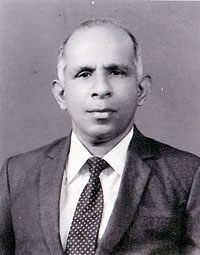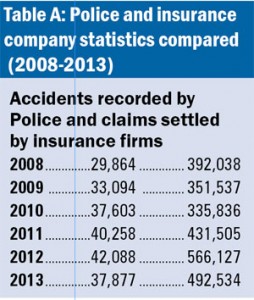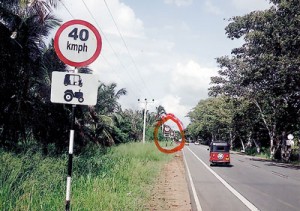Sunday Times 2
Move to increase traffic fines: Is it justifiable?
View(s):Part II
By T. Perinpanayagam
This is the second part of an article based on the 2014 Parliamentary Select Committee Report on road safety. In this article, the writer, a retired Deputy Inspector General of Police in charge of Traffic, gives his observations on the committee’s findings.

T. Perinpanayagam: Former DIG and Director Traffic
Strict implementation of existing laws
The road users in Sri Lanka, like in other developing countries, have a tendency to break traffic laws, since laws are not strictly implemented. Therefore traffic laws should be strictly enforced. The following are serious risk factors or areas where strict law enforcement by the Police is required:
n Reckless and dangerous driving, excessive speeding especially in built-up areas, incorrect overtaking, disobeying road rules, turning without signals, not stopping before entering main road from a side road, failure to dip lights at night, parking illegally — e.g. near road bends causing dangerous obstructions, driving under the influence of liquor/drugs, noise pollution through tooting of horns excessively and driving without a licence.
Accident statistics to be co-related
A comparison of accidents data compiled by the Police and the Insurance Association of Sri Lanka show a high discrepancy. (See table A) Hence the statistics can be rather misleading and not conducive to research and planning activities. Act No. 08 of 2009 requires drivers to report accidents at Police Stations. Apparently, there is reluctance on the part of drivers to report accidents at police stations perhaps due to inconvenience involved, time taken to record statements, and to get the vehicles released from stations. Coordinated effort by the Police and insurance companies will improve this situation. Traffic trained officers too are responsible for the huge discrepancy in accident statistics recorded by the Police and the claims settled by insurance companies in terms of the Act No. 8 of 2009- Section 161(i) (a) & (d)
The 2014 Parliamentary Select Committee which looked into the alarming rate of road accidents recommends that a modern accident data system be set up based on the above details. The national road safety lead agency, Ministries of Transport, Health, and Highways & RDA and the Insurance Association of Sri Lanka should have access to the system to upload and review data.
Driver Improvement Point System
Aimed at reducing road accidents, the Department of Motor Traffic under MTA section 123, 133A and 139 E came up with a driver improvement point system in driving licences. The system has not yet been implemented due to a few practical problems. Interconnecting the system of traffic cameras with the Police and the Department of Motor Traffic will lead to the proper implementation of the system.
Updating the Highway Code
The present Highway Code was gazetted in 1987. The Department of Motor Traffic should take early steps to update the Highway Code.
The then Director Traffic [undersigned] handed over this Highway Code on 01/03/1987 to the then Transport Minister. It was gazetted on July 13, 1987. Several requests to update the Code have been made to the Commissioners General of Motor Traffic in the past 30 years but little or nothing has happened.
Statistics of motor vehicles
There is a disparity between vehicles registered and the revenue licences issued in 2012. (See table B)Â The difference is very large. Perhaps vehicles damaged, destroyed or otherwise disposed of have not been deleted from the records.
Land vehicles including trailers have been included in the vehicle registration records. The Department of Motor Traffic, the Ministry of Local Government and Provincial Councils and insurance companies should make a concerted effort to correct this discrepancy.
 Endorsement form
Endorsement form
The Ministry of Transport or the Department of Motor Traffic has so far not issued endorsement forms to motorists and to new drivers who pass the driving test.
The endorsement form should be part and parcel of one’s driving licence and should be produced to a police officer on request. It refers to section 135/1A of the Motor Traffic (Amendment) Act No 8 of 2009. Any person who fails to carry a valid learners’ permit or regular driving license including the endorsement form while driving a motor vehicle shall be guilty of an offence and shall on conviction be liable to a fine not less that Rs 2,500 and not exceeding Rs 5,000.
Any person who willfully refuses to produce the learners’ permits or the regular driving licence or the endorsement form on demand by a police officer shall be guilty of an offence and shall on conviction before a Magistrate be liable to a fine not less than Rs 5,000 and not exceeding Rs 10,000.
National Policy and Action Plan
The Committee recommends that a National Policy on Road Safety be formulated based on matters highlighted in its report.
The political will and commitment, coordinated efforts of the relevant stakeholders and support of the general public will be the deciding factors in the achievement of this target. The Committee, therefore, requests the fullest cooperation of all these sectors to facilitate the desired achievement.
The Government owes this to the nation, in view of the Decade of Action for Road Safety 2011-2020 and in compliance with the UN Resolution on Road safety, which Sri Lanka has endorsed.
It is clear that the proposed increase in traffic fines for motorists cannot be justified with the restrictions and constraints placed against them since 1984 and with the inadequacy of the road capacity to cope with the increase in traffic volume by 298 percent. The motorists have been prevented from following or obeying the road rules enacted under Section 148 of the Motor Traffic Act.
The relevant Authorities are responsible for the present situation in the country in failing to provide reasonable road capacity on the roads for the smooth flow of traffic.
Therefore, the Government should withhold the proposed increase in fines until the following recommendations are fulfilled without delay by the relevant authorities.
(i)The road capacity needs immediate improvement to meet the growing transport requirement.
(ii)Transportation of all light vehicles is to be restricted temporarily.
(iii)Speed-limit boards now installed in an ad hoc manner are to be re installed at the demarcated kilometre spot within the built-up area and non-built-up area.
Provide the public with efficient and safe transport system both by road and rail.
(v) Driver improvement Point system Regulation published in the Govt. Gazette No. 1726/12 dated 5/10/2011 should be amended and implemented.
(vi) The Endorsement Form system (M. T. A 32 c Section 125 of the M. T. Act published in the Govt. Gazette No. 605/6 of 11/4/1990) is to be implemented without delay.
(vii) No Parking and Parking and Standing boards erected on all roads- A, B, AB, C and provincial roads are all invalid and illegal. Authorities have failed to erect approved sign boards with panels affixed to the boards as per Govt. Gazette No. 444/18 of 13/3/1987 prior to police prosecution.
 (viii)Â For the information of the public, Radar Speed Meter Guns to be gazetted as per Govt. Gazette No. 827/13 dated 14/6/1994 along with the procedures in detecting speeding vehicles.
(viii)Â For the information of the public, Radar Speed Meter Guns to be gazetted as per Govt. Gazette No. 827/13 dated 14/6/1994 along with the procedures in detecting speeding vehicles.
(ix) National Thoroughfare Act No. 40 of 2008: There are serious errors and omissions in the Act and in the Expressway Regulations No. 2/2011 published in the Govt. Gazette No. 1717/4 of 03/08/2011. The entire Act and the Regulation should be repealed and a fresh Act and a Regulation should be enacted.
(x) Traffic officers are to be trained (Refresher courses) prior to being detailed for traffic duties. Strict enforcement of the laws is to be observed.
The relevant authorities could take remedial measures in the coming months to reach a reasonable target before the United Nations Resolutions for Decade of Action for Road Safety 2011-2020 concludes.
A reasonable increase in fines for the 14 different category of vehicles may be considered, given the constraints placed on the motorists except for offences as stated on page 2 of the report.
Conclusion
My conclusion is that the need to increase fines for motorists would not have arisen, if the Ministry of Transport and the Department of Motor Traffic had continued with the implementation of the two Regulations — (a) Driver Improvement Points (DEMERIT POINTS) system and (b) the Endorsement Form M.T.A. 32 C. The Ministry of Transport and the Department of Motor Traffic should be held responsible for the increase in traffic accidents.
The Ministry of Highways and the Road Development Authority failed to increase the road capacity of Roads in relation to the 298 percent increase in the vehicle population.
The Government too has failed to restrict the importation of vehicles to Sri Lanka in relation to the capacity of the road network in Sri Lanka.
The Government and all relevant stakeholders should extend their fullest cooperation in achieving the desired results by taking remedial measures in the coming months to reach a reasonable target in view of the Decade of Action for Road Safety 2011-2020 and in compliance with the U N Resolutions on Road Safety.
However, prior to the implementation of the increase in the proposed traffic fines, the Government and stakeholders should first improve the ground situation such as the road capacity for the motorists to travel smoothly.
It is regrettable to note that since the Final Report was approved by Parliament on December 12, 2014, none of the stakeholders, including the Ministries, the Road Development Authority and the Department of Motor Traffic, has taken positive action to help the motorists and ensure a free flow of traffic.
There are 14 categories of vehicles as at 2015 with different sizes, weights, and dimensions. They are: Motorcycles, cars, motor tricycles, buses, dual purpose (vans/cabs), motor lorries, prime movers, lorry and others, ambulances, hearses, land vehicles, NA tractors, LV tractors and lorry trailers.

Speed-limit boards installed in an ad hoc manner in violation of the regulation. They should be reinstalled at the demarcated kilometre spot within the built-up area and non-built-up area.
One should take cognizance of the fact that vehicles have different sizes, weights and dimensions that result in the ‘occupancy’ of differing areas of ‘road space’. They pay different fees/charges for emission testing certificates.
My personal view is that due to the disparity of vehicle sizes, capacity, dimensions etc the increase in fines should not be the same for all sizes of the 14 categories of vehicles.
The previous increase in fines was gazetted by Act No. 12 of 2005. More than eleven years have lapsed. A reasonable increase in fines by 20 percent for the 14 category of vehicles may be considered given the restrictions and constraints placed on motorists on roads, preventing them from following or complying with the road rules gazetted under Section 148 of the Motor Traffic Act and other relevant Traffic laws/Regulations.
The enforcement of law in such an errant manner by the Ministry of Transport is a negation of the fundamental rights to equal protection of the law guaranteed by Article 12 (1) of the Constitution.
Copies of the above reports were delivered to the following officials on March 6, 2017:
Secretary/H.E. the President, Secretary/ Ministry of Highways, Secretary/Ministry of Transport, Secretary, Ministry of Law & Order, Secretary, Ministry of Finance, Deputy Solicitor General Yoshitha Rajakaruna, Commissioner General/Dept. of Motor Traffic, Chairman, Road Development Authority, Legal Draftsman, and Inspector General of Police.
It was also sent to the 12 Select Committee members, who approved the above report in Parliament on December 12, 2014 and to the Country Representatives of the World Health Organisation, the Asian Development Bank, the World Bank and the chairman of the Chamber of Commerce.
It is advisable to take appropriate action having digested the detailed report, before this matter is canvassed in a court of Law and in Parliament.
(The writer served as the Director Traffic & Deputy Inspector General of Police (Traffic) for more than 14 years. He also served in National Safety Councils and several National Road Safety Committees. He has engaged in Traffic Administration and Road Safety for well over 30 years in Sri Lanka. He was involved in assisting in drafting laws and regulations relating to the Motor Traffic Act and the Vehicle Ordinance since 1987.)

